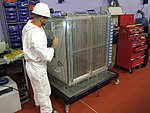Easington, North Yorkshire
Former civil parishes in North YorkshireLoftus, North YorkshirePlaces in the Tees ValleyUse British English from October 2014Villages in North Yorkshire

Easington is a village in the civil parish of Loftus, in the Redcar and Cleveland district, in the ceremonial county of North Yorkshire, England and is part of the North York Moors National Park. The village is situated on the A174 road, 1 mile (1.6 km) east of Loftus, 8 miles (13 km) east of Guisborough, and 10 miles (16 km) north-west of Whitby. At the 2011 census, the village had a population of 923.
Excerpt from the Wikipedia article Easington, North Yorkshire (License: CC BY-SA 3.0, Authors, Images).Easington, North Yorkshire
The Close,
Geographical coordinates (GPS) Address Nearby Places Show on map
Geographical coordinates (GPS)
| Latitude | Longitude |
|---|---|
| N 54.5533 ° | E -0.8505 ° |
Address
The Close
TS13 4NJ
England, United Kingdom
Open on Google Maps









